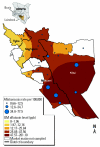Aflatoxin contamination of commercial maize products during an outbreak of acute aflatoxicosis in eastern and central Kenya
- PMID: 16330360
- PMCID: PMC1314917
- DOI: 10.1289/ehp.7998
Aflatoxin contamination of commercial maize products during an outbreak of acute aflatoxicosis in eastern and central Kenya
Abstract
In April 2004, one of the largest aflatoxicosis outbreaks occurred in rural Kenya, resulting in 317 cases and 125 deaths. Aflatoxin-contaminated homegrown maize was the source of the outbreak, but the extent of regional contamination and status of maize in commercial markets (market maize) were unknown. We conducted a cross-sectional survey to assess the extent of market maize contamination and evaluate the relationship between market maize aflatoxin and the aflatoxicosis outbreak. We surveyed 65 markets and 243 maize vendors and collected 350 maize products in the most affected districts. Fifty-five percent of maize products had aflatoxin levels greater than the Kenyan regulatory limit of 20 ppb, 35% had levels > 100 ppb, and 7% had levels > 1,000 ppb. Makueni, the district with the most aflatoxicosis case-patients, had significantly higher market maize aflatoxin than did Thika, the study district with fewest case-patients (geometric mean aflatoxin = 52.91 ppb vs. 7.52 ppb, p = 0.0004). Maize obtained from local farms in the affected area was significantly more likely to have aflatoxin levels > 20 ppb compared with maize bought from other regions of Kenya or other countries (odds ratio = 2.71; 95% confidence interval, 1.12-6.59). Contaminated homegrown maize bought from local farms in the affected area entered the distribution system, resulting in widespread aflatoxin contamination of market maize. Contaminated market maize, purchased by farmers after their homegrown supplies are exhausted, may represent a source of continued exposure to aflatoxin. Efforts to successfully interrupt exposure to aflatoxin during an outbreak must consider the potential role of the market system in sustaining exposure.
Figures
References
-
- Bhat RV, Shetty PH, Amruth RP, Sudersham RV. A food-borne disease outbreak due to consumption of moldy sorghum and maize containing fumonisin mycotoxins. J Toxicol Clin Toxicol. 1997;35:249–255. - PubMed
-
- CAST 2003. Mycotoxins: Risks in Plant, Animal, and Human Systems. Task Force Report No. 139. Ames, IA:Council for Agriculture Science and Technology.
-
- CDC (Centers for Disease Control and Prevention) 2004. Outbreak of aflatoxin poisoning—eastern and central provinces, Kenya, January–July, 2004. MMWR Morb Mortal Wkly Rep 53:790–792. Available: http://www.cdc.gov/mmwr/preview/mmwrhtml/mm5334a4.htm [accessed 20 October 2005]. - PubMed
-
- Central Bureau of Statistics 1999. Kenya: 1999 Population Census. Nairobi, Kenya:Central Bureau of Statistics, Ministry of Planning and National Development.
-
- FDA (U.S. Food and Drug Administration) 1997. Adulterated Food. Federal Food Drug and Cosmetic Act, Chapter IV: Definitions and Standards for Food, Sec 402(a)(1). Available: http://www.fda.gov/opacom/laws/fdcact/fdcact4.htm [accessed 20 October 2005].
Publication types
MeSH terms
Substances
LinkOut - more resources
Full Text Sources
Medical
Miscellaneous


